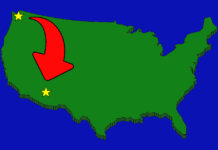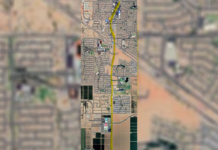
As a new mother, Pinal County’s Assistant Director of Public Health for Operations, Andrea Huerta, is keenly interested in children’s issues.
“I really am,” Huerta said. “The biggest reason is the health and safety of my child is most important. Anything to prevent future diseases and ensure her safety is my number one priority.”
Unanimously approved by the Supervisors in July 2007, the Public Health District was put in place to address some serious health care needs facing the county. One of those issues was the low immunization rate in Pinal County. The national average is 80 percent. In 2007, Pinal County was measured at 43 percent.
“The revenue collected from the Public Health District has allowed us expand our hours of operation in our clinics,” Huerta said. “According to a recent Arizona Department of Health Services (ADHS) study we can report that in the last 6 months we have seen a five percent increase in our childhood immunization rate.”
According to Huerta, the ADHS study will examine the immunization rate on two levels: the county as a whole and through the public health department.
“When ADHS studies the county as a whole they will look at the immunizations provided by the private sector and the public sector,” Huerta explained. “We expect that when ADHS looks at our public health department, they will see an improvement.”
One of the reasons officials at the county’s Public Health Department are hopeful for a rise in immunizations is the newly acquired mobile clinic. The specially designed motor home is in Maricopa two days a week providing free immunizations and administering the Women Infants and Children program.
“We are seeing an average of 20 people per week coming into the mobile health clinic,” Huerta said. “That’s 20 people that might not come to a health clinic to receive immunizations for their children.”
Huerta added that the mobile clinic averages about 80 immunizations a month even though the clinic issues those shots one day a week.
The outreach towards children from the Division of Public Health is not limited to immunizations and the WIC program. Out of 119 employed by the division, 108 of those are involved with children’s health issues in one way or another.
“We are really focusing on education and outreach,” Huerta said. “We have a lot of people working inside school classrooms and afterschool programs.”
For instance, you may find a public health nutritional educator working with second graders on good eating habits, or you may find an employee working with older students to train them to become mentors to other students.
“The youth development program is part of our abstinence outreach,” Huerta said. “We are directed by the Federal government to provide this education to students. It means that we are active in teaching youth mentors as peer support for their fellow students.
“You will also find some of our staff reaching out to educators to teach them the importance of physical activities for their students,” Huerta added.
“There is also a focus on actively reaching out to the parents of youngsters. Huerta says that with the influence parents hold over children, it’s imperative to inform them on the importance on such things as immunizations and the prevention of teen pregnancy.
“We are not only just targeting the young people,” Huerta said. “We have also worked to open up a dialogue with parents. If students can get good and reliable information from the parents, it will improve the community health outcome.”
Raising a young daughter in a growing area like Pinal County provides opportunities, as well as challenges for Huerta. But she is confident the state of public health care in this county is getting better every day.
“In less than a year since the Public Health Services District has been operating, we have already seen a marked improvement in our outreach,” Huerta said. “It makes me feel better as a county employee and a mother to see where we are going in the area of public health.”
This is the second in an eight-part series.
Up next:
Protecting Our Children: citizen volunteers round up resources for juvenile court system
Previously:
Protecting Our Children: new district allows county to better help local children
File photo

![‘Flying Bucket Fire’ doubles size, causes $200K in damage Tucson's Northwest Fire District crew members assist in firefighting efforts on the "Flying Bucket Fire" approximately 15 miles southwest of Maricopa on May 8, 2024. [Northwest Fire District]](https://www.inmaricopa.com/wp-content/uploads/2024/05/northwest-fire-district-050824-flying-bucket-fire-01-218x150.jpg)
![GAME OVER: The city government tried to get into gaming. It failed Maricopa Esports [Victor Moreno]](https://www.inmaricopa.com/wp-content/uploads/2024/05/263342f5-13e7-4668-838c-f574392086fb-218x150.jpg)



![Rizz party organizers say city ‘lying’ One of several flyers for a "TikTok rizz party" is taped to a door in the Maricopa Business Center along Honeycutt Road on April 23, 2024. [Monica D. Spencer]](https://www.inmaricopa.com/wp-content/uploads/2024/04/spencer-042324-tiktok-rizz-party-flyer-web-218x150.jpg)
![Province writer opens the athlete’s mind in new book Tom Schuman, a Province resident, poses with a copy of his new book, "My Wide World of Sports," outside his home on May 2, 2024. [Monica D. Spencer]](https://www.inmaricopa.com/wp-content/uploads/2024/05/spencer-050224-tom-schuman-sports-book-web-01-218x150.jpg)








![‘Flying Bucket Fire’ doubles size, causes $200K in damage Tucson's Northwest Fire District crew members assist in firefighting efforts on the "Flying Bucket Fire" approximately 15 miles southwest of Maricopa on May 8, 2024. [Northwest Fire District]](https://www.inmaricopa.com/wp-content/uploads/2024/05/northwest-fire-district-050824-flying-bucket-fire-01-100x70.jpg)
![GAME OVER: The city government tried to get into gaming. It failed Maricopa Esports [Victor Moreno]](https://www.inmaricopa.com/wp-content/uploads/2024/05/263342f5-13e7-4668-838c-f574392086fb-100x70.jpg)